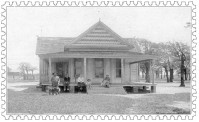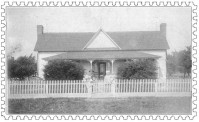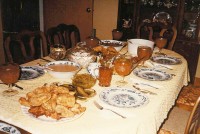
Learning to Cook from the REAL Masters
A History Lesson
If you’ve followed my columns very long, you probably know by now that I really love to cook, but what you may not know is how I came to love it. Unlike Julia Child, who apparently had some kind of culinary awakening over a specific meal of Dover sole in the south of France, the beginning of my food journey is not so much about what I ate, as who I am. So come and sit down here at my kitchen table while I pour you a cup of coffee to go with these warm cinnamon rolls I’ve just pulled out of the oven, and I’ll tell you all about it.
To really understand my love of cooking you have to go way back to these two old houses, located just a few miles apart on the dusty cotton fields around the tiny west Texas town of Clyde.
 My Mom, Gwen, was raised in the one with the big round front porch. Her Tabor grandparents moved to Clyde in 1901 and built this house in about 1903. My grandmother, Jewel, (we called her Mama Jewel) was born in this house, and grew up here with eight brothers and one sister. Later, when her young husband died, Mama Jewel moved back home to the Tabor farm with Mom who was just three years old at the time.
My Mom, Gwen, was raised in the one with the big round front porch. Her Tabor grandparents moved to Clyde in 1901 and built this house in about 1903. My grandmother, Jewel, (we called her Mama Jewel) was born in this house, and grew up here with eight brothers and one sister. Later, when her young husband died, Mama Jewel moved back home to the Tabor farm with Mom who was just three years old at the time.
 My Dad, Marshall, grew up in the house with the fence around it. The youngest of the six Jolly kids, his family occasionally share-cropped part of the Tabor land, and Mom remembers sitting on a fence post when she was about twelve, watching a handsome 15-year-old Marshall plowing in the field, and bringing him lemonade when he stopped to rest.
My Dad, Marshall, grew up in the house with the fence around it. The youngest of the six Jolly kids, his family occasionally share-cropped part of the Tabor land, and Mom remembers sitting on a fence post when she was about twelve, watching a handsome 15-year-old Marshall plowing in the field, and bringing him lemonade when he stopped to rest.
Both the Jolly’s and the Tabors moved "into town” in Clyde in the 1950’s, and when they did they brought with them all their old cast-iron skillets and dented pie pans and wooden spoons, and cans of bacon drippings and flour-dusted aprons. And they fixed the very same biscuits and black-eyed peas and cherry cobblers in town as they had in the country, so every time my family ate at their table, it was just as if we were sitting down to a meal on the farm.
Like their country kitchens, my grandmothers’ kitchens in town were pretty simple. There were no microwaves or garbage disposals or dishwashers. The floors creaked and the drawers stuck and glasses were placed upside down in the cupboard to keep the mice out. (Oddly enough though, whenever there was a piece of fried chicken left over from lunch, it was placed uncovered on a saucer up in the cupboard. Did they think mice wouldn’t notice that?) In the summer, it would get so hot that the shortening melted in the pantry, while in the winter, the warmth of the stove fogged up the windows and made the kitchen the coziest place in the whole house.
 Most of the fare that came from these old kitchens was simple, too. Meat was always fried and served with gravy. Vegetables were brought in straight from the garden and cooked to death in bacon fat. And no meal dared pronounce itself finished without a "sweet”. There wasn’t much variety in these menus. I can’t recall either of my grandmothers ever using a recipe, or even owning a cookbook. In all the years of eating in these two kitchens, I was never once served an hors d’oeuvre, Kung Pao Chicken, or Crème Brule. Those strange delights would find their way to my palette from other places.
Most of the fare that came from these old kitchens was simple, too. Meat was always fried and served with gravy. Vegetables were brought in straight from the garden and cooked to death in bacon fat. And no meal dared pronounce itself finished without a "sweet”. There wasn’t much variety in these menus. I can’t recall either of my grandmothers ever using a recipe, or even owning a cookbook. In all the years of eating in these two kitchens, I was never once served an hors d’oeuvre, Kung Pao Chicken, or Crème Brule. Those strange delights would find their way to my palette from other places.
But simple as they were, these kitchens were the heart and soul of my love for cooking. It was here that I learned how to sift and season and slice and stir. It was here that I learned the hard way about hot grease and sharp knives, about lumps in the gravy and too much salt. It was here, standing at the elbow of the masters, that I unlocked the mysteries of dough. And most of all it was here that I learned to love not only the food that was served, but the joy of serving it to others.
So here’s to those steamy old kitchens in those drafty old houses, and to those wonderful women who cooked there. I will never forget them.
- Search for Around the Table articles similar to "Learning to Cook from the REAL Masters.
- Search all articles similar to "Learning to Cook from the REAL Masters".
- List all Around the Table articles.
Terms & Conditions | Contact | Login | This website designed by Shawn Olson